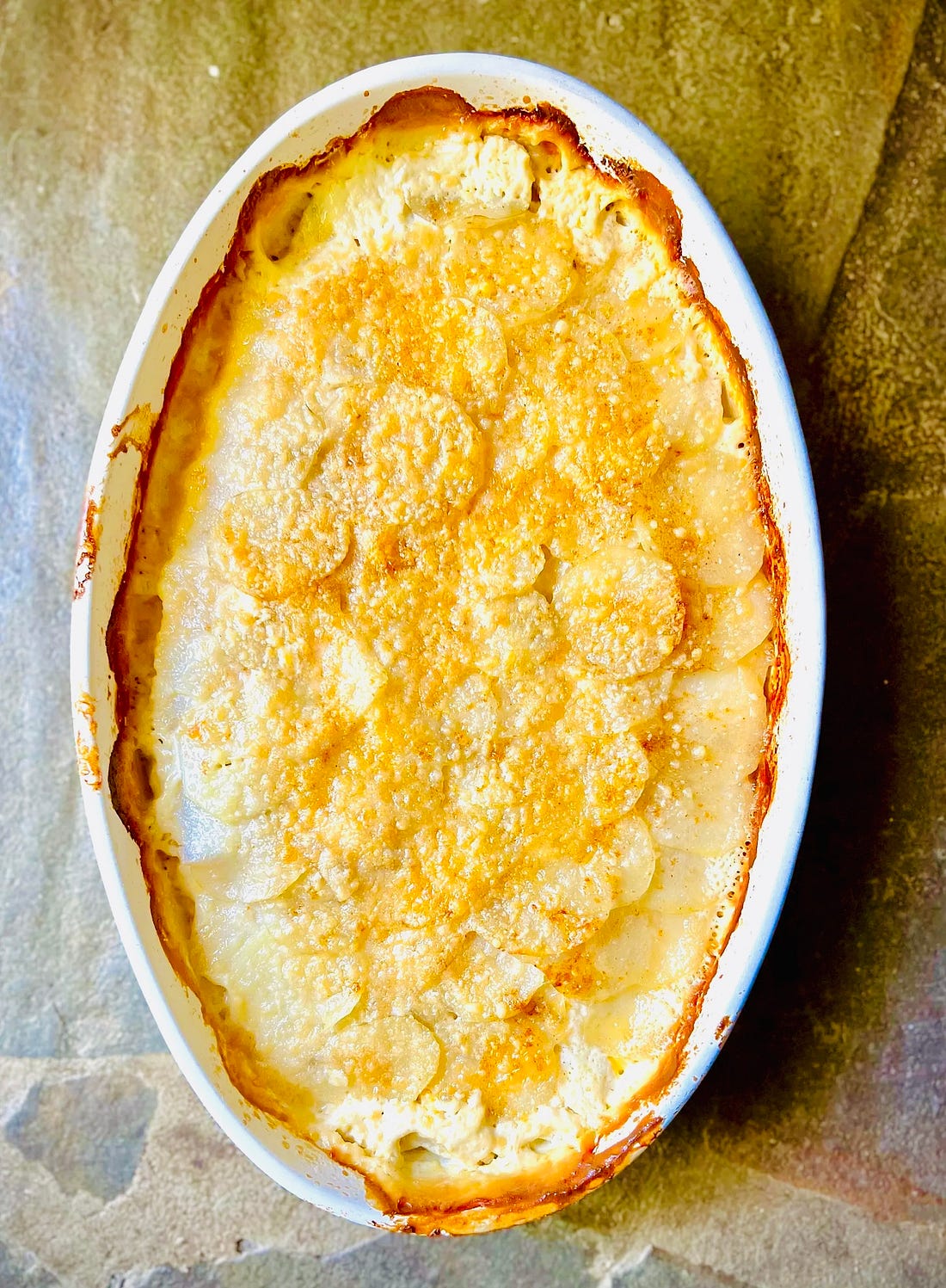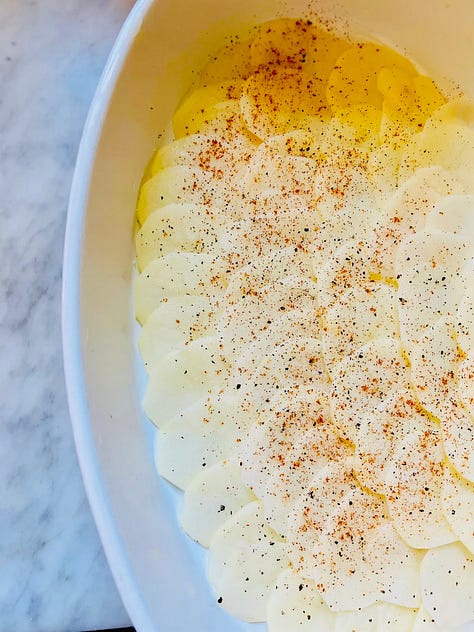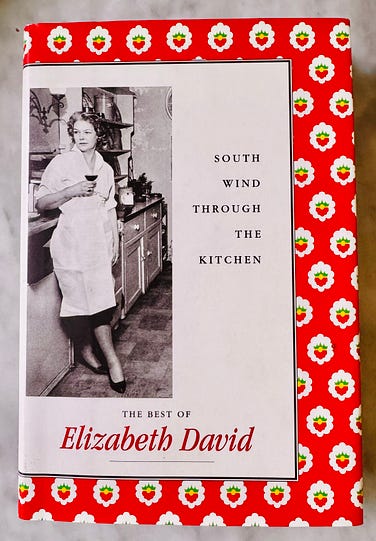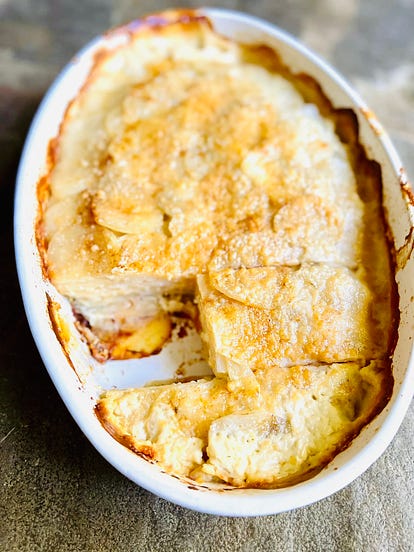Thank you for reading Between the Layers! Please enjoy and share this free post with your friends. Gratin Dauphinois + Elizabeth David - No. 331I want to curl up with comfort food and an old cookbookI WALKED INTO This & That Thrift Shop in Nashville recently to donate some clothing and gift my cookbook to one of the shop’s longtime volunteers, Ann Egerton. Ann is the widow of John Egerton, acclaimed Southern writer, who died way too young back in 2013. John once told me over lunch that every recipe has a story. No sooner had I handed Ann my book than she hands me a just-donated copy of the South Wind Through the Kitchen cookbook. The book said it contained ‘’the best’’ of British food writer Elizabeth David and was published posthumously in 1998. So I bought the Elizabeth David book for $6 and sat down with it this past stormy weekend. As rain sheeted off our roof and thunder booms sent our dog Ella to the closet to hide, I was someplace in southeastern France placing a pan of Gratin Dauphinois in the oven and learning about a food writer I never knew. Elizabeth Gwynne was comfortably born in the English village of Folkington in 1913, the daughter of a Tory MP and granddaughter of a viscount. She had nannies, cooks, and governesses during her Sussex life, according to longtime editor Jill Norman who compiled South Wind Through the Kitchen, sharing Elizabeth’s recipes and stories. (The title comes from Elizabeth’s 1964 essay about her lover and culinary mentor, the novelist Norman Douglas, who wrote a book called South Wind, published in 1917.) Elizabeth fled her upper-class life after boarding school and pursued a more Bohemian one acting in Paris then running off with Douglas ‘’to Greece and then settling in Cairo, where she worked for the British government,’’ according to Artemis Cooper who wrote Elizabeth’s authorized biography Writing at the Kitchen Table in 1999. In Cairo she met and married Anthony David, an officer in the British Indian Army. After World War II, Elizabeth returned to war-torn England, where through newspaper and magazine food writing she gently coaxed the British out of drab rationing recipes to fresher Mediterranean fare like spinach tarts, lightly grilled fish, eggplant, zucchini, and pesto. Her first cookbook, A Book of Mediterranean Food, was published in 1950 and was way ahead of its time. ‘’Olive oil was unknown except in chemists,’’ Artemis Cooper writes, ‘’where it was sold as a cure for waxed-up ears.’’ Elizabeth David’s story reminds me of the life of Julia Child who in the 1960s showed suburban America how to make souffle and other French delicacies. Julia worked for America’s O.S.S. (Office of Strategic Services, an intelligence organization) during the Second World War and studied French cooking in Paris before she wrote cookbooks. But unlike Julia, Elizabeth never made it to television. She did, however, open a kitchenware shop called Elizabeth David Limited in London in 1965, where she sold French copper and Le Creuset pans, one of the first stores of its kind. Elizabeth David died in 1992 at 78, and her London memorial service was followed by a grand lunch of favorite recipes, from tuna and white bean salad to fresh figs for dessert. I remember moving to England the year after she died and hearing her belongings were to be sold at auction. Great British Bake Off judge Prue Leith paid a huge sum for Elizabeth’s kitchen table where books were written and possibly potatoes were once sliced for this gratin. A true Gratin Dauphinois ‘’is made only with potatoes and thick fresh cream,’’ says Elizabeth confidently in her introduction to the recipe. Her recipes are in prose style as if she is speaking with you in the kitchen. She first instructs you to ‘’Peel 1 lb. (450 g) yellow potatoes, and slice them in even rounds no thicker than a penny.’’ (Her British penny, although larger in size than the American penny, was about the same thickness.) How do you make potato gratin? Do you have an favorite Elizabeth David recipe?The recipe’s namesake, the Dauphine, was a historic province in southeastern France. Today this area is bordered by the Alps and Italy to the east, the Rhône River to the west, and Provence to the south. Depending on the season, lavender might be in bloom or olives or grapes might be harvested. This is where the outstanding Valrhona chocolate was first made. From 1350 to 1830, Dauphin (the masculine version of the word) was a title given to the eldest son, the heir apparent, of a king of France. It all goes back to the purchase of lands in Dauphiné in 1349 by the future Charles V. According to the French culinary encyclopedia, Larousse Gastronomique, dairy cows and high quality Dauphiné cream make a potato gratin better than the rest. And while Elizabeth says that some recipes for Gratin Dauphinois, like Escoffier’s (she’s very good at name dropping), include eggs and cheese, those are more of a ‘’gratin savoyard.’’ You get the feeling she knows what she speaks. Gratin nitty-gritty from Elizabeth DavidReading further into Elizabeth’s recipe, a favorite of her nephew Johnny Grey, she advises a mandoline to slice the potatoes. Elizabeth takes an extra step to rinse the sliced potatoes in cold water. Then she pats them dry with a towel and layers the potatoes much like I do in a shallow dish first rubbed with garlic and then buttered—a nice touch. She seasons them with salt and pepper. (I go one step further and season each layer, alternating grated good Parmesan or shredded Gruyere and a sprinkle of freshly ground nutmeg between layers.) Then, she pours over heavy cream. She bakes the gratin in a low oven first, and then in the last 10 minutes cranks up the oven to high (400ºF) with bits of butter and cheese on top to get a golden crust. (See the recipe below for my baking covered variation.) As for potatoes, Elizabeth prefers them firm and waxy. (I concur but have also made excellent gratins with the tender Russets.) She says to use enough potatoes to nearly fill the pan…’’the potatoes and cream should, always, fill the dish to within approximately three-quarters of an inch of the top.’’ After spending a rainy afternoon with Elizabeth David, I can imagine she might have said, with one hand on her hip and a cigarette dangling from the other, that her Gratin Dauphinois is simply the best. She served it as a main course with a green salad. And wine. To me, getting to know a recipe like this not only makes dinner parties a snap but helps me understand someone I never knew. John Egerton was right about every recipe having a story. Maybe even two. - xo, Anne P.S. Did you catch my cookbook segment on CBS’s The Dish last Saturday? If not, here’s the link. Many thanks to the CBS producers and crew as well as host Michelle Miller, in the photo above. Big thanks, too, to my publicist Carrie Bachman for making this happen. The Baking in the American South inventory on Amazon, B&N, and the Bookshop sold out this past weekend, but I am told more copies are on the way. If you need the book this week, head to your local indie bookstore! The Foyer has copies at a nice sale price, too, until 4/1. Coming this Thursday for paid subscribers, my take on the NYT favorite recipe called Marry Me Salmon. (It’s fabulous even the second day. So would that be Marry Me Again Salmon? Just wondering…) Book Tour continues! I’ll be at Eagle Eye Books in Decatur, Georgia at 7 pm on March 25 in conversation with bestselling author Mary Kay Andrews. And I’ll be at the historic Old Mill in Pigeon Forge, Tennessee at 1 pm on March 29 talking with writer and historian Jimmy Proffitt of the Appalachian Tale, so come see me and sample some old-fashioned cornbread! THE RECIPE: Gratin Dauphinois from Elizabeth David (et Moi)Use as many potatoes, peeled, sliced as thinly as a penny as David says, to fill the dish. Layer with seasonings. Pour cream around the perimeter until the dish sloshes. For extra flavor, infuse the cream with aromatics like fresh thyme sprigs and peppercorns in a saucepan, bring to a simmer, turn off the heat and let cool, then strain and use in the recipe. Leftovers are fabulous reheated uncovered in a hot oven until bubbly. The best thing about this recipe is that it keeps the menu simple, doable, and everyone loves it. Makes 8 to 12 servings Prep: 30 to 35 minutes Bake: 65 to 75 minutes
You’re on the free list for Anne Byrn: Between the Layers. If you’re liking what you’re reading, why don’t you become a paying subscriber for more recipes, stories, and content. |













0 comments:
Post a Comment